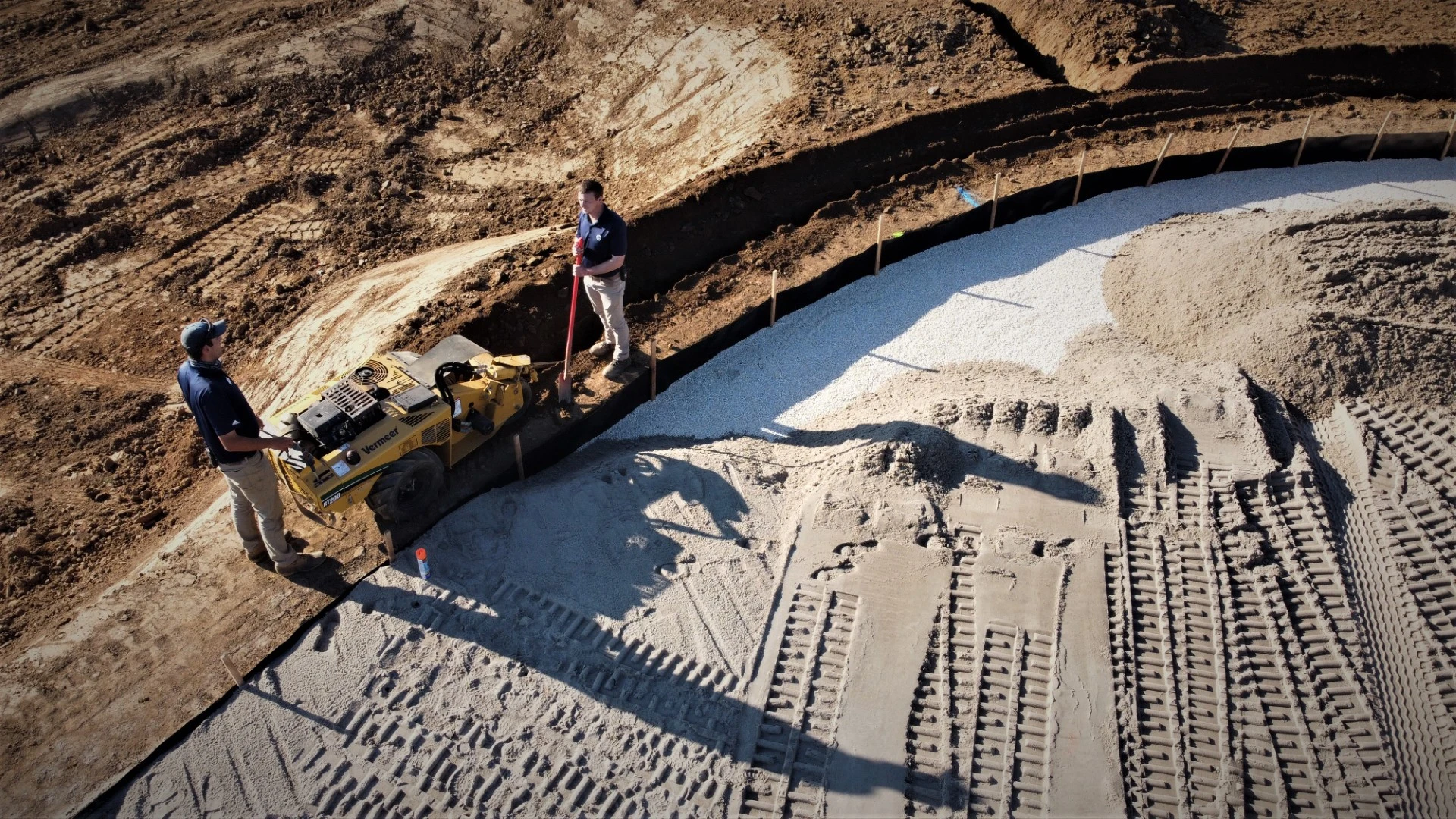

Steve Eller describes himself as “an old dog learning new tricks.” In dog years, Eller would be somewhere around 9 or 10, depending on his breed. In human years, he is fast approaching 63. “My superintendents all use moisture meters,” he says. “I still get my pocketknife out and cut into the ground a lot, you know?”
And yet here he is, two seasons in to using — and fully embracing — the USGA’s GS3 smart golf ball for daily maintenance at Colorado Golf Club, about 30 miles southeast of downtown Denver.
“It’s been fun to have this information to track what you’re doing instead of just relying on observation,” says Eller, the head greenskeeper, who has worked at the club for a decade and in the industry for about four decades. “It’s really interesting to track your data. I’m surprised how much I look at it.”
What Eller looks at — in conjunction with course superintendent Tauge Rux, who normally measures three or four greens with the GS3 six days per week — is smoothness, trueness and firmness. They all have a number, day after day, that measures health and playability. And all those numbers, uploaded to the USGA’s DEACON Management System, can have a direct effect on maintenance.
“We look at how our other maintenance practices affect those numbers and what we can expect from them when we do, say, a light topdress,” Eller says. Thanks to data gleaned from two seasons of GS3 measurements, “We’ve been able to reduce the number of topdressings this year and still manage our organic matter and our soil and our firmness and everything we want the greens to be,” Eller adds. “It’s actually helped us reduce things we used to do instead of adding things.”
This year feels like a turning point for the still-new tech. The team at Pinehurst Resort used the GS3 in advance of the U.S. Open (see Open Season, June 2024) and dozens of clubs and courses have added it to their toolbox. More discussion about the ball’s readings and data have started to appear on social media — and, far more important in certain regions of the industry, at local meetings and at the bar after those local meetings.
“If it doesn’t come up at the bar after the association event, it’s not going to catch on,” says Pat Quinlan, the superintendent for the last six years at Fairmount Country Club in Chatham, New Jersey. “But it has come up at our board meetings with the association.” Quinlan recalls a recent conversation during which a few local superintendents at clubs with larger budgets learned he was using the GS3. “‘Wait a minute,’” he remembers them saying. “‘Why does Fairmount have something that we don’t have?’ Now whether they go and get it, I don’t know, but I saw the look on their faces.
“When moisture meters came out, people were like, ‘Ah, I don’t need that. I know where it’s wet. I know where it’s dry,’” Quinlan continues. “And then it started just like this — all the top-100 clubs had it and it quickly generated to all levels of club had to have one. I bet you can go to even the mom-and-pops and they’re going to have one. I kind of see the (GS3) ball going the same route. No one wants to be the last guy — especially if your members are going to call you out on it.”
Like Eller and Rux, Quinlan started using the GS3 around the start of the 2023 season. He initially measured 10, 13, or sometimes even 14 greens every day before talking with USGA officials and learning that three or four would be plenty. Like anything else — in maintenance and in life — the key is consistency. Quinlan has added measuring greens with the GS3 to his to-do list most days. And, because he considers himself a “boots-on-the-ground” superintendent, he often executes the readings. “I’m not wearing loafers,” he says with a laugh.

Quinlan relies on DEACON for a variety of data, including clipping yields. “We do clipping yields on four greens,” he says. “We don’t spray or fertilize each green differently — I guess you water them each a little differently — but does it matter if 14 has a little more clippings than 4? Are you going to do something different? Are your mowers cutting the same later on as they are at the beginning? That’s something that we’ve looked at with both the GS3 and clipping yield: Is the first green the mower is cutting as good as the last green it cuts?”
Quinlan also relies on the ball and DEACON off the course, downloading charts directly to include in presentations to boards and committees. “They love it because they’re all Wall Street people, they’re all Manhattan people, and that’s what they look at every day,” he says. “They look at charts, they look at data, and there’s no more guessing.”
Quinlan doesn’t know exactly how much he’s saved by relying on charts generated by data he’s already plugged into DEACON, but he has saved at least time if not a little money.
“It’s difficult for me to say we’ve saved any money, but I think we’ve dialed our program in better and improved playability,” he says. “We’re not a daily-fee course, so how do you put a number on that?” As far as ROI, though: “I think member satisfaction has gone up.”
Elsewhere along the East Coast, Scott Mauldin, CGCS, is using DEACON to measure clipping yield data at Bayville Golf Club in Virginia Beach — he joined the team during course construction in early 2022 — and has sketched out some back-of-the-envelope math about how much it can save him.
Looking at that clipping yield data, Mauldin is already able to determine whether greens need to be mowed with probably five people, or just rolled with one or two. “If I see clipping yields and they’re staying at a certain number that I like them to stay at, in theory, it can save me three or four people,” he says. “That’s where we want to be with data. How do we make a better plan with the data that we have?”

Mauldin calculates that if the clipping yield on a particular green is about 128 ounces, about 13 to 14 ounces per 1,000 square feet, “then I know that following day I really don’t need to go mow,” he says. “I can go roll. Then I got three people at, call it $18 an hour, that’s $54 an hour that I’m probably not going to use for four hours. That’s $216. Now how many times do I do that in a year? Twenty? Thirty? Forty? I haven’t had (the GS3) long enough to quantify that, but if you did it just five times a month, that’s $1,000. It’s not to say you’ll do that every month, it might just be wintertime. But if you did it during most of our growing months, April 15 to November 15, you’ve more than got your money back. And that’s just one day a week.”
Mauldin says the GS3 allows him and his team to have a better understanding of how the greens will perform due to the smoothness and speeds for that day’s play, and DEACON allows him to have several data points on file for the greens.

“With this information, I feel that I can make management choices for scheduling culture programs,” he says. “The GS3 allows you to have more information on your own golf course to relate it to what your members might want to see on a day-to-day basis.”
And information is king. At Colorado Golf Club, Rux normally measures from the same six or eight spots on greens. He normally skips Mondays — when the team vents and topdresses — then checks Tuesday numbers and compares them to the weekend. By Wednesday or Thursday, the numbers are right back in line.
“Sometimes, it feels like a lot to try to get out on four greens every day, but it does feel like it’s worthwhile information,” Rux says. “I would love to find time to do it on nine holes one day and nine holes the next day. It’s a matter of finding the time right now.” Rux estimates that change would add somewhere between 30 minutes and an hour per day.
“Everything’s got a cost, whether it’s dollars or time to do it,” Eller says. “It’s just a matter of committing to it. What is the cost of not doing that kind of data collection? It’s something for a lot of courses to consider.”

Explore the October 2024 Issue
Check out more from this issue and find your next story to read.
Latest from Golf Course Industry
- Standard Golf announces new product lineup for 2025
- The Salt Pond taps Troon for management
- KemperSports selected to manage Swansea Country Club
- From the publisher’s pen: Grab that guide
- Introducing our April 2025 issue
- South Carolina leaders honor golf course superintendent
- One and only
- Wild can be good






